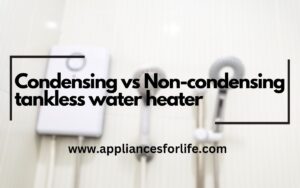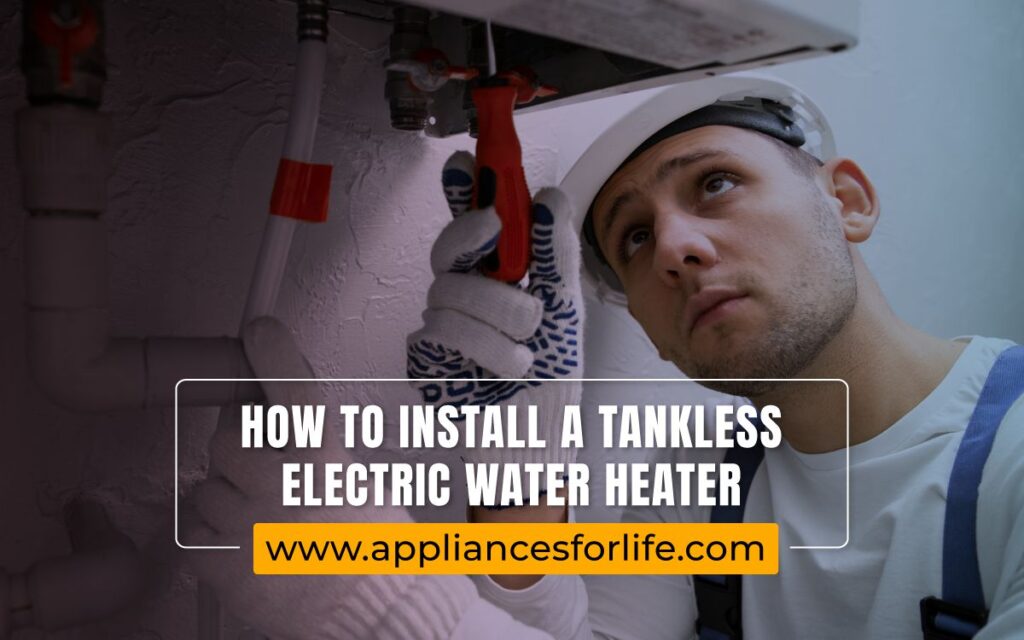How To Install A Tankless Electric Water Heater
- A tankless electric water heater can be a great investment for your home. They are much more efficient than traditional water heaters and can save money on your energy bill. If you are thinking about installing a tankless electric water heater, there are a few things you need to know. In this article, we will give you a step-by-step guide on how to install a tankless electric water heater.
Installing a tankless electric water heater in your home can be a great way to save money on your energy bill. Tankless electric water heaters are much more efficient than traditional water heaters, and they can last for many years with proper maintenance.
Tankless electric water heaters heat water on demand rather than storing hot water in a tank. This means that you will always have hot water and will not have to pay to heat a tank of water you are not using. Tankless electric water heaters are also much smaller than traditional water heaters, so they take up less space in your home.
They are also much safer than traditional water heaters because they do not have a hot water tank that could leak and cause damage to your home. Tankless electric water heaters are a great option for people who want to save home space and save money on their energy bills.
They are also much more efficient because they only heat water when you need it. Traditional water heaters must keep a tank of water hot all the time, even when you are not using it. This wastes a lot of energy and can lead to higher energy bills.
Tankless electric water heaters can save money on your energy bill and are also better for the environment. Tankless water heaters do not use fossil fuels to heat water, so they do not produce greenhouse gases.
Tankless electric water heaters are also much more efficient than traditional water heaters. They use less energy to heat water, saving you money on your energy bill. Tankless electric water heaters are a great option for people who want to save money and help the environment.
Before we get into how to install a tankless electric water heater, let’s take a quick look at some of the benefits of this type of water heater and how they can help keep your home running smoothly.
Benefits of Tankless Electric Water Heaters
There’s a lot to love about tankless electric water heaters. The debate of whether or not tankless electric water heaters are better than their gas counterparts remains relevant today, especially among homeowners looking for the best choice for their homes. There are several benefits of installing a tankless electric water heater in your home:
They’re energy-efficient
Tankless electric water heaters are much more efficient than traditional water heaters, so you will see a decrease in your energy bill each month. They do not have a storage tank of hot water like traditional water heaters, so they only heat the water when you turn on the faucet. This means there is no heat loss from the storage tank, so you only pay for the energy to heat the water you use.
Tankless electric water heaters are also much smaller than traditional water heaters, so they will take up less space in your home. This is especially important if you have a small home or an apartment. They are also much safer than traditional water heaters because there is no risk of a gas leak.
They can last for many years
Traditional water heaters typically need to be replaced every 5-10 years, but tankless electric heaters can last 20 years or more with proper care. Maintenance is key to prolonging the lifespan of any tankless electric water heater. Be sure to follow the manufacturer’s recommendations for care and maintenance. If you encounter a problem, it can usually be fixed with a simple repair.
Because they don’t have a tank full of water, they are less likely to develop rust and other problems. Additionally, there are no pipes connected to a tankless water heater, so there is no risk of leaks. As long as you keep an eye on the water pressure and flush the unit every few months, your tankless water heater should give you many years of trouble-free service.
They are small and compact
Tankless electric water heaters take up much less space than traditional water heaters, so they are perfect for homes with limited space. These types of water heaters can be hung on a wall, which frees up floor space in your home. Tankless electric water heaters are also very energy-efficient because they only heat water when needed. This means that you’ll save money on your energy bill each month.
Since they don’t have a storage tank, they heat water on demand, so there is no need to worry about running out of hot water. There are many different brands and models on the market, and the one you choose will depend on your needs and budget.
Installation is easy
Installation is easy and can be done by a qualified electrician. It’s important to note that tankless electric water heaters require a dedicated circuit. You cannot install the heater on the same circuit as other appliances. Tankless electric water heaters are a great choice for homeowners who want the convenience of hot water on demand.
These small units can be installed in various locations, making them a great choice for homes with limited space. Tankless electric water heaters are also a good choice for people who want to save money on their energy bills. These units are very efficient and can save you money in the long run.
They are safe for the environment
Electric water heaters do not produce harmful emissions, so they are better for the environment than gas water heaters. Additionally, they are very safe to use, and there is no risk of explosion or fire. This is because there is no open flame, and the water is heated by electricity. This means there is no chance of the water heater exploding, eliminating the risk of carbon monoxide poisoning. Electric water heaters are also much cheaper to operate than gas water heaters and have a longer lifespan. This is because no moving parts can break down and do not require ventilation.
Things To Consider Before Buying A Tankless Electric Water Heater
You should consider a few things before purchasing a water heater. This will help you choose the right model for your home and needs. The size and capacity of the unit and the climate in your area are important factors in your decision. In addition, you should consider the type of water heater that best suits your home and family. Let’s explore these points below;
Size of the unit
The first thing to consider is the size of the unit. Measure the space where it will be installed, so you know what size to buy. If you get a unit that is too small, you will constantly run out of hot water. Not only is this a major inconvenience, but it also wastes a lot of energy as the water heater will constantly run. Conversely, if you get a too-large unit, you will pay for energy you are not using. To get the most efficient unit, make sure only to buy the size that you need. Thankfully, there are sizeable tankless electric water heaters for small homes.
To help you with this, use a water heater sizing calculator. With this tool, you can input the number of people in your household and the amount of hot water each person uses daily. With this information, the calculator will be able to tell you the size that you need.
The climate in your area
Another important consideration is the climate in your area. If you live in a cold climate, you will need a unit that can handle freezing temperatures. Some units cannot be installed in very cold climates. You will need to check the specifications of the unit you are considering to be sure it can be installed where you live.
You will also want to be sure the unit you select can handle the cold weather. Some units are not designed for cold weather and will not work properly in freezing temperatures.
You should also consider the amount of ice and snow in your area. If you live in a hot climate, you will need a unit that can handle high temperatures. You should also consider the amount of humidity in your area.
Type of the water heater
Finally, you must decide if you want a point-of-use or whole-house unit. Point-of-use models are smaller and can be installed under a sink or in a small closet. Whole-house models are larger and must be installed by a professional. These models will provide softened water to every faucet in your home.
The downside to whole-house models is that they require more maintenance than point-of-use models and can be more expensive. You will also need a professional to install the unit, which can add to the overall cost. The upside to whole-house models is that they provide softened water to every faucet in your home. This can be a big benefit if you have hard water.
How To Install A Tankless Electric Water Heater
If your home is like most, the water heater is one of those appliances you don’t think about until it stops working. That’s when you realize just how important it is to have a reliable hot water supply. If your water heater is starting to show its age, or if it has stopped working altogether, it may be time to replace it with a new one
There are many different types and models of water heaters on the market, but one type that has become increasingly popular in recent years is the tankless electric water heater. Tankless water heaters have many advantages over traditional storage tank water heaters, including an endless supply of hot water, lower energy bills, and peace of mind knowing that you have a safe and reliable water heater.
If you’re considering installing a tankless electric water heater in your home, this step-by-step guide will show you how to do it.
Choose the right location
Choose the right location for your tankless water heater. The unit must be installed indoors, so pick a spot that is convenient and easily accessible. Many models can be mounted on a wall, which helps save space. Keep in mind that the unit will need a gas line or an electrical connection, so make sure it is close to the necessary hookups. Also, ensure that there is enough clearance around the unit for proper ventilation.
Turn off the power at the main breaker box
Turn off the power to your home at the main breaker box. This is a safety precaution to prevent electrocution. Once the power is off, locate your home’s main water shut-off valve and turn it to the “Off” position. Depending on the age of your home, this valve may be located in the basement, near the water heater, or outside near the water meter.
Remove the old water heater
Remove the old water heater. You must disconnect the gas line if you have a gas water heater. You will see a large metal nut—the gas shut-off valve. Unscrew it by hand or with a pipe wrench. If you have an electric water heater, first turn off the power at the breaker box. Next, remove the two wires connected to the top of the water heater.
If you have an electric water heater, you must disconnect the power. Drain the water from the water heater by attaching a garden hose to the drain valve at the bottom of the tank and running the hose outdoors. Turn off the valve and disconnect the hose when the water runs clear. Next, remove any anode rods or dip tubes from the tank.
Install the new water heater
Install the new water heater according to the manufacturer’s instructions. Use the two screws provided in the kit to secure the bracket to the wall. Make sure the gas line is properly connected and tighten all connections. The next step is to connect the cold water line.
Re-check the anode rod to ensure it is still in good condition. The anode rod is a part of the water heater that protects the tank from corrosion. Follow the manufacturer’s instructions if the anode rod needs to be replaced.
Hand-tighten all connections before using any tools. This is to avoid over-tightening and damaging the pipes. Once all the connections are hand-tight, use a pipe wrench to finish tightening them. Consult the instructions with your water heater to determine the correct level of tightness.
Turn the power back on
Turn on the power to your home and test the new water heater by turning on a hot water faucet. Allow the water to run for a few minutes to ensure it is heated properly. If the water is not hot, check the circuit breaker to ensure it is turned on and reset any tripped breakers. If the breaker trips again, there may be a short in the wiring leading to the water heater. In this case, you should call an electrician to investigate and repair the issue. If the breaker does not trip and the water is still not hot, the water heater may be faulty and need to be replaced.
Frequently Asked Questions
1. Can I install an electric tankless water heater myself?
Installing a tankless water heater is a complicated process that most
homeowners should only attempt with professional help. While electric tankless
water heaters are easier to install than gas models, both types require
experience and knowledge. Hiring a professional to install an electric tankless
water heater will ensure the job is done right and help prevent any accidents
or injuries that could occur during installation.
2. What are the electrical requirements for an electric tankless water heater?
Electric tankless water heaters are very convenient. They can be
installed in any home and provide an endless hot water supply. However, before
purchasing an electric tankless water heater, you must ensure that your home’s
electrical system can handle the additional load. Most electric tankless water
heaters require a dedicated circuit with a capacity of 30 amps.
3. What are the downsides of an electric tankless water heater?
The electric tankless water heater has its potential problems. One of
the potential problems is that the heating elements in these tankless water
heaters can burn out. This can be a very costly repair. Another potential
problem with electric tankless water heaters is that they can be very slow to
heat up the water.
Wrapping Up
Installing a tankless electric water heater is a relatively simple task that most homeowners can do themselves. With this guide, you can know that your new water heater will be installed correctly and safely. The first step is to turn off the power to the circuit breaker. Next, you will need to disconnect the cold water supply line from the water heater. Once that is done, you must disconnect the hot water outlet from the water heater. The next step is to remove the access panel from the water heater.
01 HOURS 6 MINUTES
ESTIMATED TIME DESIGNING AND UPLOADING THIS ARTICLE
11 HOURS 12 MINUTES
ESTIMATED TIME RESEARCHING AND WRITING THIS ARTICLE
You Might Also Like

The Best Rheem Professional Classic Rtex Electric Tankless Water Heaters
If you’ve been looking for high-quality tankless water heaters, you may have encountered Rheem. Rheem is a household name with decades of experience in water heating, and this article explores some of the best Rheem professional classic Rtex electric tankless water heaters. A standard Rheem

Condensing vs Non-condensing tankless water heater
What Exactly Is a Tankless Water Heater? If you cannot associate with the group identified above, you may need to learn what tankless water is and what it does- a tankless water heater is exactly what it implies, a water heater without a tank. Traditionally,

Electric Tankless Water Heaters For A Small House
Best Electric Tankless Water Heaters For A Small House Not all tankless water heaters are created equal. If you have a small home, you’ll want to ensure you get an electric tankless water heater specifically designed for small homes. This article will review the 7

Pros And Cons Of Tankless Gas Water Heaters
Pros And Cons Of A Tankless Gas Water Heaters A tankless gas water heater is a newer, more efficient type of water heater that doesn’t use a storage tank. Instead, it heats water on demand, saving you money on your energy bill. Consider the pros

How To Install A Tankless Electric Water Heater
How To Install A Tankless Electric Water Heater A tankless electric water heater can be a great investment for your home. They are much more efficient than traditional water heaters and can save money on your energy bill. If you are thinking about installing a

Top 5 Best Tankless Water Heaters for a Large Home
Some appliances have become so important that they are no longer considered luxury items but necessities. The water heater is one of those necessary appliances for every household nationwide. They’re so important that a report from Energy Star reveals that 7-7.8 million units of these

A Simple Step by Step Guide to Flushing Your Tankless Water Heater
A tankless water heater is a great choice for people with many people in their household. It is a good choice for people with a lot of people in their household because it does not use much water. However, a tankless water heater needs constant

